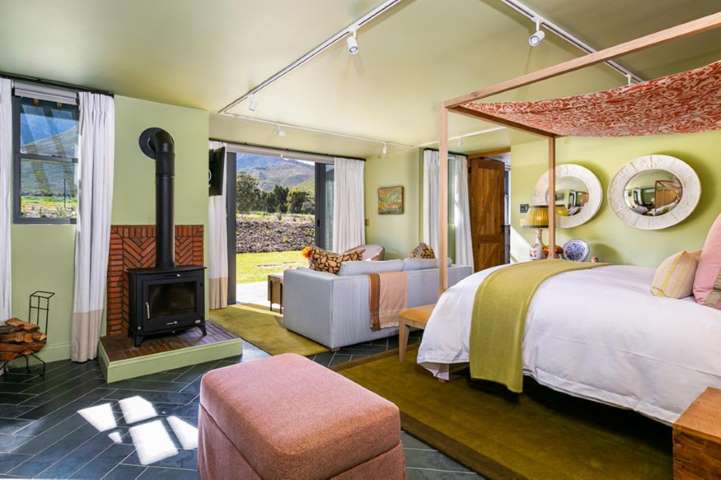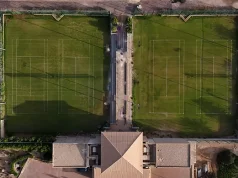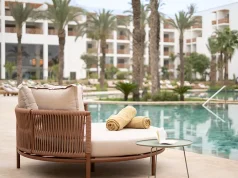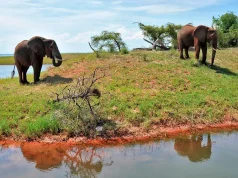
ALWAYS something new out of Africa, so the saying goes. And, it seems, there’s always something new at BOSJES farm in the scenic Breedekloof valley in the Western Cape winelands. Spring in the Southern Hemisphere marks the opening of the Herehuis, a luxurious eight-bedroom guest lodge located in the farm’s original 18th-Century manor house
“We realised that we need more accommodation, especially for our wedding parties,” explains Carlen Vorster, CEO of Hospitality & Marketing for BOJSES. “When the Herehuis was no longer being used as a private residence we decided to commence a project that incorporates the Die Skuur guesthouse with the manor house along with a new wing of accommodation. The end product will provide BOSJES with 12 rooms and suites along with stellar indoor and outdoor public spaces.”
The Herehuis offers eight spacious guest suites. This includes two well-appointed rooms within the original manor house, alongside six suites in a new wing built and renovated at the rear of the property. With a range of room categories available, Herehuis offers an ideal winelands destination for both couples, multi-generational family groups and wedding parties.
For more than 200 years the BOSJES Herehuis has stood on the slopes of the Waaihoek Mountains, gazing out across the Breedekloof. So, in reimagining the property, it made perfect sense to lead architect Tiaan Meyer of Meyer & Associates Architechts that the graceful building should remain the focal point of this storied working farm.

“Our architectural design approach focused on keeping the historic Herehuis, with its Cape Dutch gable, the main focus element on the farm,” explains Meyer. “The Herehuis, together with the iconic BOSJES Kapell, act as the two main anchors on the farm.”
And while the exterior of the historical manor house was untouched, the new accommodation to the rear subtly celebrates the property’s agricultural heritage. Contemporary in design, the new suites have been sensitively incorporated into the aesthetic of the farm with shed-like forms and the use of dark corrugated sheeting as a reference to the original farm buildings.
Traditional whitewashed walls surround a series of outdoor courtyards, creating wind-free spaces home to tranquil rose and herb gardens, as well as a spacious terrace around the heated pool.
The six guest suites in the new wing are also connected by covered outdoor walkways “to emphasise the fact that this is still a working rural farm,” says Meyer. “There is no mimicking of the past in the architectural language employed, yet there is a clear distinction between what is old and what is new, and all the rooms have been designed to maximise the views and the magnificent setting at BOSJES.”

A striking aesthetic
That heritage-first design language extends to the décor and design, a task entrusted to Liam Mooney of Liam Mooney Design Group.
“A lot of our design decisions were made to reference the history of the property, but without being beholden to the past,” explains Mooney, who previously curated the esthetique for the farm’s Winkel, Spens and Die Stalle Spa. “What’s important is balance. You can have contemporary and you can have old, they just need to work together. As a farm, BOSJES is rich in history, but it also definitely looks forward.”
A perfect example is the manner in which the graceful curves of the original gable have been subtly incorporated into the interiors, from the wave of cane furniture in the Sun Room to the sweep of camelback chairs in the intimate library. In the en-suite bathrooms, gabled mirror tops and a basket-weave tiling pattern – a subtle reference to traditional riempie chairs – ensure the past is celebrated in a contemporary manner.
The décor of the Herehuis also had to fit within the aesthetic language of the wider BOSJES Farm, so Mooney turned to subtle visual cues to ensure the new addition stood out, while seamlessly fitting in. Brass is a thread linking the various destinations, while organic wood textures are a subtle link to both winemaking and the original woodwork within the manor.
The building dates to 1790 and retains many of its original features, including the stately wooden doors that greet guests on arrival. In the main entrance hall, look out for the muur-kas, or in-set wall cupboard. It is one of just three in the valley handcrafted by Italian prisoners-of-war who were accommodated in the farm’s stables after World War II. On BOSJES, the ornate cupboard is exquisitely crafted of waboom (Protea nitida), yellowwood and stinkwood.

Alongside these antique pieces rest wonderful contemporary creations, including items conceptualised and created by Mooney’s production studio Valentim, alongside furniture by celebrated craftsmen including James Mudge, Allan Lutge and Pier Rabe. Lighting was given equal attention, with Mooney tapping into the talents of Dokter and Misses, Ernst Eloff and Joe Paine to install signature pieces across the property. Equally eye-catching is the bold use of fabric, adding texture and colour to the space. The vibrant floral motif on the bed canopies is particularly striking and sure to become a talking point for guests.
A taste of the valley
While guests enjoy easy access to the BOSJES Kombuis and BOSJES Spens during the day, come evening Herehuis residents are well catered for in the newly built Eetkamer.
This contemporary space offers a chalkboard table d’hôte menu each evening. The menu follows a similar culinary style to the Kombuis, with contemporary bistro cuisine built on both seasonality and local farm produce.
The Eetkamer has been beautifully designed as a garden room, “wrapped in glass to invite the gardens and the setting, visually, inside,” explains Meyer. “The timber screen and ceiling structure reference similar elements on the farm, specifically the BOSJES Spens, where the intricate timber trellis folds into the building itself.”
With the BOSJES Herehuis running smoothly, the second phase of development is already underway to further expand the overnight facilities on the farm. Set alongside the Herehuis, the original Die Skuur guesthouse will be remodelled to offer more luxurious guest suites, incorporating and expanding the guest lodge’s capacity to 12 rooms in total, while the existing lounge is to be converted into an executive conference facility. The hugely popular Die Stalle spa is also due for expansion, doubling in size, with the addition of hydrotherapy facilities to establish BOSJES as a wellness destination in the winelands.
To enquire about the BOSJES Herehuis accommodation, visit www.bosjes.co.za.





